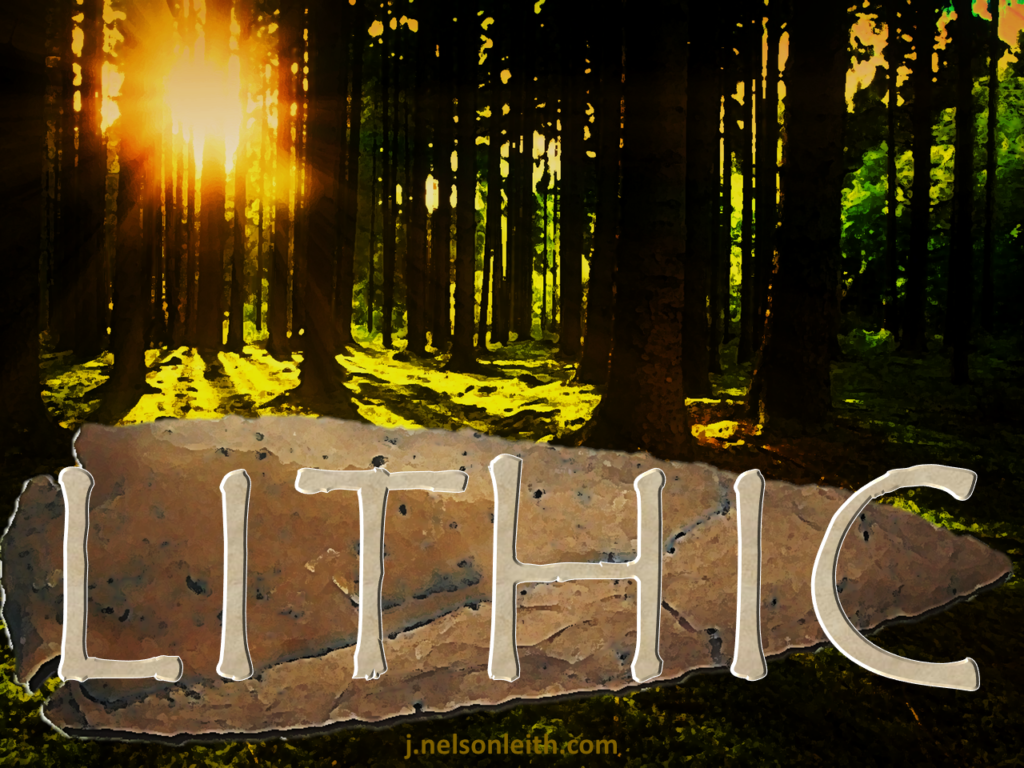 Get this: Roaming around the gorgeous landscape of a Stone Age fantasy world; hunting (and being hunted by) strange, archaic creatures; encountering subtle shamanic magics and strange spirits; and defending your clan or trading with other clans.
Get this: Roaming around the gorgeous landscape of a Stone Age fantasy world; hunting (and being hunted by) strange, archaic creatures; encountering subtle shamanic magics and strange spirits; and defending your clan or trading with other clans.
What is it? A massive, open-world MMORPG taking advantage of great advances in video game technology, particularly in building immersive and beautiful worlds. Players join regional clans with distinctive survival environments, artistic styles, and material resources. A very subtle magic system serves to maintain a “mythically realistic” air, wherein the world appears natural, but with supernatural influences hidden under the surface.
Working Title: Lithic
DETAILS (IF THE PITCH HOOKED YOU)
This is just a bare-bones sketch of what such an MMORPG would look like, drafting the overall strategic direction of a game that would need filled in by coders and consultants drawn from among archeologists, anthropologists, and survival experts. Basically, I’ve just worked out the regional clan system, made decisions about the tone and atmosphere of the game, and slapped down a very basic map to represent as many environments as conceivable for a Stone Age setting.
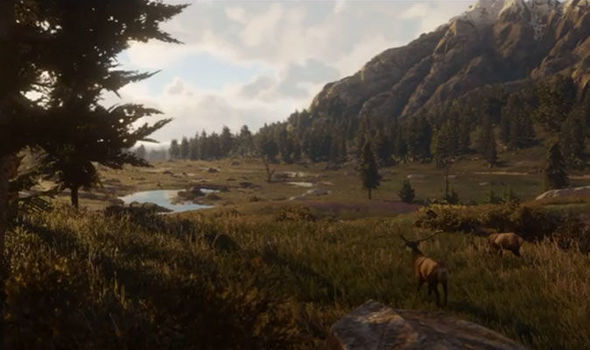
My central drive here is that open-world games are beautiful. Red Dead, Grand Theft Auto, Far Cry—one of the best aspects of these games is the immersive experience. While Far Cry Primal partly achieved the immersion in a Stone Age setting, it lacked variety in its environment and the full immersion of a factional MMORPG.
I also wanted to address some complaints I’ve had about other games: that the wilderness areas weren’t completely explorable (looking at you, Assassin’s Creed), that the buildings weren’t all explorable, and that fantasy games were so overwhelmed by flashy magic that all immersive realism gets thrown out the window. They come off as silly, with cartoonishly psychedelic colors and cartoonishly oversized weapons. If you like that, fine, but there’s something to be said for gritty realism in fantasy.
With a Stone Age game, the buildings would be kept to a minimum, which frees up code-space for wilderness areas. The basics of this sort of open environment are already worked out in other MMORPGs. Also, the low-tech setting keeps crazy equipment overload to a minimum. In other words, gameplay is focused on gameplay, not swag-hoarding.
Lastly, I want a game where advancement is based more on base-building, knowledge-building, and REPUTATION-building rather than generic, power-gaming “leveling up.” I like advancement that gives devoted players something to work for without making new players sitting ducks. The disadvantage for noobs should be that they’re noobs, unfamiliar with the setting, not that they’re at “level 1” while others are at “level 56.” Being a noob is bad enough.
BASIC GAMEPLAY : ATTRIBUTES
Before we go on, let me introduce the four basic attributes of characters, each made up of four sub-attributes (or just “subs”) which can be adjusted at character creation and affected during gameplay both permanently and temporarily. Each attribute has a set base level, let’s say 16, which can then be redistributed, point for point among the subs, say a base of 4 with an upper limit of 8 and a lower limit of zero which means a complete loss of the sub-attribute. In general, each clan gets two attribute penalties and two attribute bonuses. We’ll be talking about attributes a lot, so let’s get them out of the way.
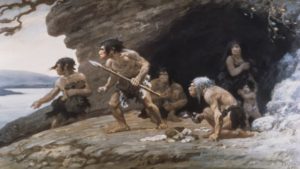 BODY – This primary attribute is essentially the “hit points” of the character, and is the same for all characters except where clan bonuses apply. When BODY reaches zero, the character dies (and respawns at the nearest healer, of whichever clan, a dynamic worked out later). The four subs define the character’s physical presence.
BODY – This primary attribute is essentially the “hit points” of the character, and is the same for all characters except where clan bonuses apply. When BODY reaches zero, the character dies (and respawns at the nearest healer, of whichever clan, a dynamic worked out later). The four subs define the character’s physical presence.
FEROCITY – Helps strike more often and more viciously in combat, some types of hunting, and any time the character is trying to destroy something, which can be a hindrance if the player wants to hold back. This is essentially the sub of the “damage per second” (DPS) RPG archetype. When this reaches zero, the character can no longer attack.
STRENGTH – Influences certain kinds of damage, influence over physical objects, and how much the character can carry. Also, changes the character’s appearance. This is part of the classic “tank” RPG archetype. When this reaches zero, the character can no longer move.
HARDINESS – Helps with resisting weather, disease, starving, wounds, etc. Does not include supernatural influences. HARDINESS affects how many BODY points are lost when the character is hurt, and how fast the character heals without assistance. This is also part of the classic “tank” RPG archetype. When this reaches zero, all other BODY subs begin to drain points.
AGILITY – Helps with combat, hunting, climbing, crafting, basically any skill that requires physical adroitness. When this reaches zero, the player can no longer control the character’s actions.
PERSON – This primary attribute reflects the “comfort” of the character, partly a reflection of BODY’s “hit points” but representing how the pain influences the character’s actions. Thus, while BODY determines how close the character actually is to death, the PERSON attribute mediates between BODY and the ability of the character to take action. As PERSON drops—due to wounds, temperature, hunger, etc.—the character’s actions (and perception, via the screen and audio) become less focused and effective. The four subs define the character’s personal presence:
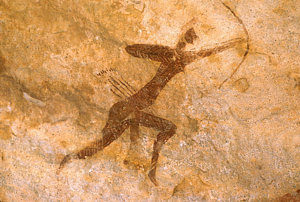 MIND – Helps with hunting, gathering, and crafting, basically any skill that requires thinking. MIND reaching zero renders the PC incapable of any action.
MIND – Helps with hunting, gathering, and crafting, basically any skill that requires thinking. MIND reaching zero renders the PC incapable of any action.
HEART – Helps with crafting, particularly artistic pieces, basically any skill where the value of the product involves its aesthetic excellence. This is particularly useful in that it increases the types of materials (especially the colors of materials) the character can use in crafting. HEART reaching zero renders the PC incapable of any aesthetic expression and removes all PERCEPTION indicators (see PERCEPTION for what these are).
GRIT – Determines the character’s ability to ignore the behavioral effects of wounds, weather, intoxicants, etc. Includes physical and supernatural influences. GRIT affects how reduced the character’s ability to move, perceive, and act on skills is affected as BODY is reduced. GRIT reaching zero renders the PC incapable of action as they huddle in place.
CHARM – Determines the character’s ability to influence NPCs. CHARM reaching zero renders all NPC reactions to the PC hostile.
PERCEPTION – This primary attribute is essentially just an aggregate of the four subs, which individually change the way the game world is presented through the character visually and audibly. When any PERCEPTION sub reaches zero, the player will have no input from that source, which can be disabling to gameplay but ironically within the spirit of immersive gameplay. PERCEPTION subs can be reduced (or enhanced) by ingested substances, and can be reduced by physical, BODY damage. This attribute does not include spiritual perception, which is handled under the SPIRITUALITY attribute.
DAY VISION – This affects the player’s daytime view, picking out different details to enhance. This is reflected by what the player sees on-screen, and which targets are subtly outlined when the character is aiming either with a weapon or a resource-gathering skill.
NIGHT VISION – This affects the player’s nighttime view, lightening the screen and also reflected by which targets are subtly outlined when the character is aiming with either a weapon or a resource-gathering skill.
HEARING – This affects the player’s audio input, picking out different details to enhance. The game would have background, “ambience” audio based on the environment, and specific audio based on creatures and other characters, including dialogue. Better HEARING would enhance the specific audio while worse HEARING would enhance the ambience audio.
SCENT – This affects the on-screen display of scents driven by wind, a color-based indicator based on basic color codes: black for fire/smoke and cooking foods, green for vegetative scents, orange for animal scents, and blue for water scents. With better SCENT, these indicators are more vividly displayed on-screen based on proximity to the source.
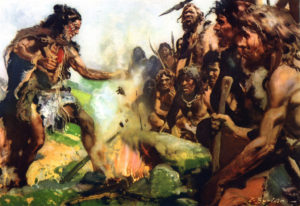 SPIRITUALITY – The primary attribute is essentially just an aggregate of the four subs, which determine the character’s interaction with the supernatural, fantasy aspects of the game world, which include magical influences, plants, and creatures.
SPIRITUALITY – The primary attribute is essentially just an aggregate of the four subs, which determine the character’s interaction with the supernatural, fantasy aspects of the game world, which include magical influences, plants, and creatures.
POWER – Helps with creating magic totems (a catch-all terms for idols, items that cause area affects at certain sites, and decorations that imbue items with magical power), performing immediate shamanic magic (spells), and influence over spirits.
SEEING – Enables the character to detect magical auras and supernatural creatures. This is displayed on-screen with color-coded indicators that differ in shape and color from the SCENT indicators: white for helpful magic, red for harmful magic, yellow for protective magic, and purple for charming magic which influences NPC behavior strongly but can also influence the PERCEPTION, PERSON, and SPIRITUALITY subs of player characters.
ACCORD – Provides the character resistance to harmful supernatural effects and superior benefit from helpful supernatural effects. This sets a baseline for all characters, so that ACCORD below 4 is essentially a relative penalty.
FORESIGHT – Provides the character specific insights into upcoming in-game events, as well as increased range on SEEING and PERCEPTION, often enhanced by spells or ingested substances. The insights are a form of divinity/prophecy driven by dreams or prophetic visions into which game-runners can drop hints to planned in-game events via cinematics.
THE MAP AND THE FACTION SYSTEM
The map I have here is admittedly rough. I purposefully did not want to do a more high-def map to leave the details up to the developers, who might come up with cool ideas, like making this shore swampy and that one rocky, or placing a random mountain in the middle of a plain or forest. I also wanted to design the basic map essentially to sketch out the six basic clan coalitions (subdivided into clans) that define the faction system of the game.
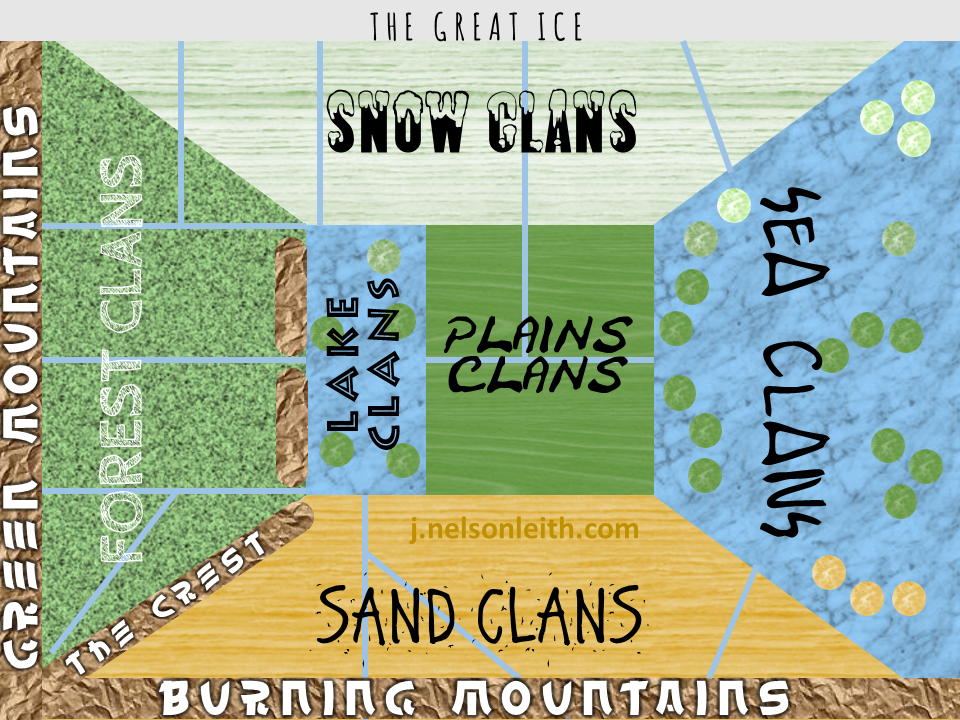 I specifically did not want to name the regions, rivers, and bodies of water to allow players to establish their own names for landscape features during the course of gameplay. I did name the mountain ranges simply to have something to write on the map, but these could be changed if the player settled on new names. The developers would need to keep up with how the players were referring to different features and assign names based on this.
I specifically did not want to name the regions, rivers, and bodies of water to allow players to establish their own names for landscape features during the course of gameplay. I did name the mountain ranges simply to have something to write on the map, but these could be changed if the player settled on new names. The developers would need to keep up with how the players were referring to different features and assign names based on this.
This would be fun for players and developers, but there would have to be some effort put in to avoid obscene (although, our own world has the Teton Range) and pop culture references.
My vision here is to set up six major eco-regions for clan coalitions as super-factions, divide these regions up into two or three clan territories each as basic factions, and allow players to set up “bands”—teams within these clan territories—with “headquarters” for these bands.
There would also be three initial, “primal” bands per clan for PCs to start in. These primal bands would have very limited territory with the majority of the starting clan coalition territories being pure wilderness to provide opportunities to set up new bands. Competition for open territory should be pretty fierce among early adopters, and later players might simply find themselves searching for a good band to join.
Joining new bands within one’s clan or, later, within one’s clan coalition or even in other coalitions once things develop, should be made easy from a gameplay perspective, once you’ve earned the trust of PCs and NPCs in the faction you want to join. How one does this is explained later.
Within this factional freedom, however, I would want to maintain the integrity of the social setting by imposing presentational styles on the clan factions via body and artistic limitations. Thus, if you choose X clan, your character’s dress, weapon styles, and housing architecture should be drawn via in-game social dynamics to X clan styles. Deviating from these styles would, at the very least, inspire suspicious reactions from in-band NPCs, and would indicate a divided loyalty to PCs.
With this presentational dynamic, a player could—in most cases—immediately identify the clan or even band of another player based on appearance and dress, eliminating the need for overhead displays that disrupt immersive gameplay. These presentational indicators are explained somewhat in the clan descriptions below. Instead of just reading a distracting overhead display, a player would have to read an encountered character’s clan identity based on appearance and then actually gesture or talk to them to see what their intentions were.
So, let’s go into the basic map regions, clan coalitions, and factional clans all of which are embedded in the world at the beginning. These categories include diverse environments, unique material resources (which can drive trade), different flora and fauna, and significant physical landmarks. I’ll go into each of these by region. The map itself is made up of clan coalition eco-regions with basic geographic details like rivers outlined in the most simple terms to give developers some artistic freedom.
All clans begin play as hunter-gatherers, with animal domestication and plant cultivation yet to be discovered. Some clans have technologies that others do not (yet!) enjoy, providing skill-based benefits to certain factions.
SNOW CLANS. This northern region is an Ice Age landscape of mammoth, woolly rhino, elk, and musk oxen herds; cave bears, cave lions, saber-toothed cats, archaic hyenas, and dire wolves; and archaic NPC humanoids representing Homo heidelbergensis, a primitive form of Neanderthal. The northern ice cap forms the northern border, a white wall thousands of feet high constantly shedding huge chunks of ice. There are icy plains that only flower briefly in the summer, rocky hills, copses of evergreens here and there, and a few rugged mountains. Four major rivers, and many frigid streams arise from the ice cap and split the terrain, becoming deluges in summer as the region warms up.
The Snow Clans are Neanderthal-Denisovan types. They have a characteristic stocky, short build, and a facial structure emphasizing the brows and de-emphasizing the chin. They wear furs and generally fight with spears. Caves are the “headquarters” for their bands, and thus players must identify a suitable cave to set up a band headquarters, and caves might already have someone (or something!) claiming them as home.
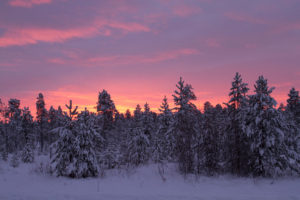 Fire Clan. These characters live in the east of the northern realm, a hilly area between the ice cap to the north and forests to the south. They have pale, pinkish skin; reddish, curly hair; green or blue eyes; and a stocky, short build. Penalty to HEART and CHARM, bonus to FEROCITY and HARDINESS. They wear pale furs, fight with spears, and decorate in orange and black paint. Some unique resources of their region are opal, pink mammoth ivory, and ermine fur, which is the white-and-black fur of the stoat that can only be gathered during winter.
Fire Clan. These characters live in the east of the northern realm, a hilly area between the ice cap to the north and forests to the south. They have pale, pinkish skin; reddish, curly hair; green or blue eyes; and a stocky, short build. Penalty to HEART and CHARM, bonus to FEROCITY and HARDINESS. They wear pale furs, fight with spears, and decorate in orange and black paint. Some unique resources of their region are opal, pink mammoth ivory, and ermine fur, which is the white-and-black fur of the stoat that can only be gathered during winter.
Most foxes throughout Fire Clan territory turn from red to white as winter approaches, but those in a central stand of evergreens remain red year-round and hunting them is strictly taboo. This evergreen stand is holy to the Fire Clan and engaging in violence there affects a Fire Clan character’s SPIRITUALITY negatively over the long-term. The three primal bands of the Fire Clan are arranged from the forest verge in the southwest to the border with the Smoke Clan in the southeast, with wild areas to the northwest.
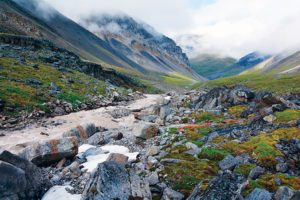 Smoke Clan. These characters live in the middle of the northern realm, a mountainous, rocky area. They have tan skin; brown, curly hair; hazel or brown eyes; and a stocky, short build. Penalty to HEART and CHARM, bonus to NIGHT VISION and SEEING. They live in caves, wear dark furs, fight with spears, and decorate in blue and white paint. Some unique resources of their region are rubies, red woolly rhino horns, and gray beaver furs. The Smoke Clan have access to meat smoking for preservation, which is initially denied to other clans.
Smoke Clan. These characters live in the middle of the northern realm, a mountainous, rocky area. They have tan skin; brown, curly hair; hazel or brown eyes; and a stocky, short build. Penalty to HEART and CHARM, bonus to NIGHT VISION and SEEING. They live in caves, wear dark furs, fight with spears, and decorate in blue and white paint. Some unique resources of their region are rubies, red woolly rhino horns, and gray beaver furs. The Smoke Clan have access to meat smoking for preservation, which is initially denied to other clans.
The white mammoth is an occasional mutation among the red and brown mammoths in the valleys of Smoke Clan territory, and the appearance of a white mammoth has great spiritual and magical significance. There is also a broad vale hidden among their mountains, a sacred site where violence results in long-term, negative SPIRITUALITY nerfs. The three primal bands of the Smoke Clan are arranged from the western river border with the Fire Clan to the plains eastern border with the Ember Clan, with wild areas to the north.
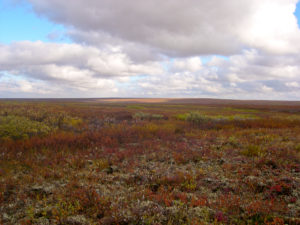 Ember Clan. These characters live in the west of the northern realm, a vast coastal plain dotted by copses of evergreens. They have dark skin; black, curly hair; brown or black eyes; and a stocky, short build. Penalty to GRIT and CHARM, bonus to HARDINESS and STRENGTH. They wear red furs, fight with spears, and decorate in green and red paint. Some unique resources of their region are amber, walrus tusks, and white tiger fur.
Ember Clan. These characters live in the west of the northern realm, a vast coastal plain dotted by copses of evergreens. They have dark skin; black, curly hair; brown or black eyes; and a stocky, short build. Penalty to GRIT and CHARM, bonus to HARDINESS and STRENGTH. They wear red furs, fight with spears, and decorate in green and red paint. Some unique resources of their region are amber, walrus tusks, and white tiger fur.
There is a high mesa in the midst of their territory around which many cave bears dwell, which makes the approach very dangerous. Atop this mesa is a circle of stones in which rituals and clan-wide trading sessions take place. Members of other clans also often take part in these market events. The three primal bands of the Ember Clan are arranged from the mountainous western border with the Smoke Clan to the eastern shores beyond which are the Sea Clans. To the northeast is wilderness.
FOREST CLANS. This western region is a mountain-ringed woodland landscape of mastodons, shoveltusks, and gomphotheres; leopards, tigers, and flightless, predatory birds; and archaic NPC humanoids representing Gigantopithecus and Homo floresiensis. The western border is the impassable Green Mountains range, with forests reaching far up their slopes.
The Forest Clans are variously statured people, with generally dark skin and hair. They tend to shave parts or all of their heads. Forest Clan bands can establish their headquarters in caves but also in houses on flat areas atop hills and plateaus.
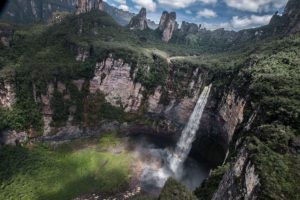 Rain Clan. These characters live in the southern rain forests of the western realm, a rugged jungle with many forested plateaus and waterfalls. They are are tall (5’10’ to 6’6″) and have very dark skin; black, curly hair; and brown or hazel eyes. Penalty to NIGHT VISION and ACCORD, bonus to CHARM and STRENGTH. They wear woven leaf clothes, fight primarily with clubs and stone daggers, and decorate in yellow and red paint with bead accents. Some unique resources of their region are gold, rare amberwood, and red tiger fur. When not living in caves, their houses are mud-and-wood roundhouses.
Rain Clan. These characters live in the southern rain forests of the western realm, a rugged jungle with many forested plateaus and waterfalls. They are are tall (5’10’ to 6’6″) and have very dark skin; black, curly hair; and brown or hazel eyes. Penalty to NIGHT VISION and ACCORD, bonus to CHARM and STRENGTH. They wear woven leaf clothes, fight primarily with clubs and stone daggers, and decorate in yellow and red paint with bead accents. Some unique resources of their region are gold, rare amberwood, and red tiger fur. When not living in caves, their houses are mud-and-wood roundhouses.
There is a high mesa deep in Rain Clan territory ringed by waterfalls. Atop this mesa is a square of large stones where rituals and trading take place, often including other clans. The three primal bands of the Rain Clan live in the southeastern part of territory near the mountain pass that allows the southern forest river to enter the lake. To the west are wilds until the Green Mountains.
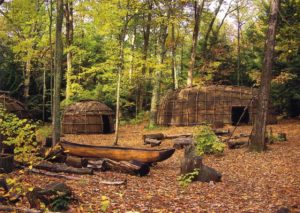 Storm Clan. These characters live in the temperate forests of the western realm, a generally flat woodland with a few rocky-topped hills here and there. They are generally short (5′ to 5’10”), have dark ruddy skin; brown or black, straight hair; and brown or gray eyes. Penalty to DAY VISION and FEROCITY, bonus to SEEING and AGILITY. They wear leather clothes, fight primarily with clubs and hand axes, and decorate in white and black paint with feather accents. Some unique resources of their region are tobacco, beaver furs, and copper, although copper-working is not available at the beginning of the game. When not living in caves, their houses are bark roundhouses.
Storm Clan. These characters live in the temperate forests of the western realm, a generally flat woodland with a few rocky-topped hills here and there. They are generally short (5′ to 5’10”), have dark ruddy skin; brown or black, straight hair; and brown or gray eyes. Penalty to DAY VISION and FEROCITY, bonus to SEEING and AGILITY. They wear leather clothes, fight primarily with clubs and hand axes, and decorate in white and black paint with feather accents. Some unique resources of their region are tobacco, beaver furs, and copper, although copper-working is not available at the beginning of the game. When not living in caves, their houses are bark roundhouses.
There is a sacred hot springs deep in the Storm Clan territory, surrounded by a square of large stones, where bathing rituals take place. The three primal bands of the Storm Clan are clustered in the eastern part of the territory near the mountain passes that allows the central forest rivers to enter the lake. To the west are wilds until the Green Mountains.
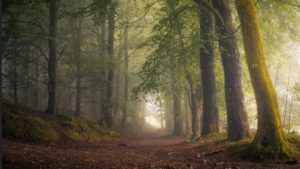 Mist Clan. These characters live in the northern evergreen forests of the western realm, a woodland broken up by rocky hills and often obscured in fog. They are mid-statured (5’6″ to 6’3″), have ruddy skin; brown or dark red, wavy hair; and brown or green eyes. Penalty to AGILITY and NIGHT VISION, bonus to ACCORD and STRENGTH. They wear red, black, and white furs; fight primarily with bows and hand axes; and decorate in green and black paint with horn or antler accents. Some unique resources of their region are emeralds, yew for crafting better bows and arrows, and salted boar meat. When not living in caves, their houses are stone pit-houses with bark roofs.
Mist Clan. These characters live in the northern evergreen forests of the western realm, a woodland broken up by rocky hills and often obscured in fog. They are mid-statured (5’6″ to 6’3″), have ruddy skin; brown or dark red, wavy hair; and brown or green eyes. Penalty to AGILITY and NIGHT VISION, bonus to ACCORD and STRENGTH. They wear red, black, and white furs; fight primarily with bows and hand axes; and decorate in green and black paint with horn or antler accents. Some unique resources of their region are emeralds, yew for crafting better bows and arrows, and salted boar meat. When not living in caves, their houses are stone pit-houses with bark roofs.
There is a sacred grove of dogwood in the midst of the Mist Clan territory, within which is a square of large stones where rituals and trading events are held. The three primal bands of the Mist Clan are clustered in the northeastern part of the territory near where the north forest river skirts the end of the mountains to pour into the lake.
SAND CLANS. This southern region is an arid land. There are camelids, antelopes, goats, giraffids; lions, hyenas, leopards, jackals, and monitor lizards; and archaic NPC humanoids representing Australopithecus. The southern border is the impassable Burning Mountains range, a dry and rocky slop rising from the desert.
The Sand Clans are tan-skinned, with light body hair but ample bears and head hair. They wear wear woven linen or cotton clothes. Sand clan bands establish headquarters in caves or by constructing mud-brick houses.
 Sun Clan. These characters live in the arid western hills of the southern realm, a rugged region with many flat-topped hills and hidden pools. They are generally short (5′ to 5’10”), and have light tan skin; black, curly hair; and brown or hazel eyes. Penalty to NIGHT VISION and GRIT, bonus to STRENGTH and POWER. They fight primarily with slings and daggers, and decorate with green and blue paint with flower accents. Some unique resources of their region are gold, hot spice, and figs. When not living in caves, they live in stone round-houses with thatched roofs. They also erect megalithic stones to measure the passing of the sun.
Sun Clan. These characters live in the arid western hills of the southern realm, a rugged region with many flat-topped hills and hidden pools. They are generally short (5′ to 5’10”), and have light tan skin; black, curly hair; and brown or hazel eyes. Penalty to NIGHT VISION and GRIT, bonus to STRENGTH and POWER. They fight primarily with slings and daggers, and decorate with green and blue paint with flower accents. Some unique resources of their region are gold, hot spice, and figs. When not living in caves, they live in stone round-houses with thatched roofs. They also erect megalithic stones to measure the passing of the sun.
One mesa in Sun Clan territory is an especially sacred site where a large megalithic temple is used for seasonal rituals. The three primal bands of the Sun Clan live in the northeast part of the territory near the Crest. To the south and southwest are arid wilds.
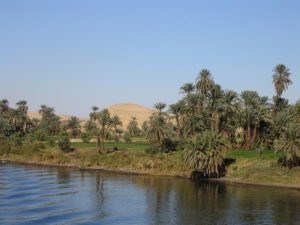 Moon Clan. These characters live in the dry, flat lands in the middle of the southern realm, a desert of dunes and river valleys. They are generally tall (5’10” to 6’6″), and have tan skin; black, wavy hair; and brown or gray eyes. Penalty to SCENT and AGILITY, bonus to MIND and SEEING. They fight primarily with bows and clubs, and decorate with yellow and red paint with bone accents. Some unique resources of their region are silver, hippo tusks, and dates. They live in grass and mud-brick huts. They also erect megalithic stones to measure the passing of the moons.
Moon Clan. These characters live in the dry, flat lands in the middle of the southern realm, a desert of dunes and river valleys. They are generally tall (5’10” to 6’6″), and have tan skin; black, wavy hair; and brown or gray eyes. Penalty to SCENT and AGILITY, bonus to MIND and SEEING. They fight primarily with bows and clubs, and decorate with yellow and red paint with bone accents. Some unique resources of their region are silver, hippo tusks, and dates. They live in grass and mud-brick huts. They also erect megalithic stones to measure the passing of the moons.
At the confluence of the two major rivers of Moon Clan territory is a flat-topped mount with a megalithic temple used for seasonal rituals. The three primal bands of the Moon Clan live near this site, to the south is desert wilderness, and there is a stretch of river north of them where (at the beginning of the game) nobody lives until the lake.
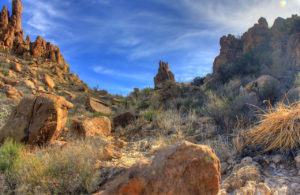 Star Clan. These characters live in the arid eastern hills of the southern realm, a rugged region with many flat-topped hills and cliff-side caves. They are mid-statured (5’6″ to 6’3″0, and have light tan skin; black or brown, curly hair; and brown or amber eyes. Penalty to DAY VISION and HARDINESS, bonus to HEART and FORESIGHT. They fight primarily with bows and daggers, and decorate with blue and black paint with shells accents. Some unique resources of their region are sapphire, incense, and almonds. They live in stone and mud-brick houses. They also erect megalithic stones on hilltops to measure the movement of stars.
Star Clan. These characters live in the arid eastern hills of the southern realm, a rugged region with many flat-topped hills and cliff-side caves. They are mid-statured (5’6″ to 6’3″0, and have light tan skin; black or brown, curly hair; and brown or amber eyes. Penalty to DAY VISION and HARDINESS, bonus to HEART and FORESIGHT. They fight primarily with bows and daggers, and decorate with blue and black paint with shells accents. Some unique resources of their region are sapphire, incense, and almonds. They live in stone and mud-brick houses. They also erect megalithic stones on hilltops to measure the movement of stars.
North of the river in this territory is a cluster of sacred hills, atop the largest of which is a megalithic temple where seasonal rituals and trading events take place, often including other clans. The three primal Star Clan bands live near this temple.
SEA CLANS. This eastern region is a ocean territory with multiple archipelagoes, subarctic, temperate, and tropical. There are archaic sharks and whales; giant squids and octopuses; flightless predatory birds; giant tortoises; monstrous arthropods and crustaceans; and archaic NPC humanoids representing Homo floresiensis. The eastern border is an endless sea that eventually gives way to violent storms that drive boats back into the game area.
The Sea Clans are generally tan-skinned, with light body hair and no beards. Sea clan bands establish headquarters in clusters of round-houses and navigate the seas in canoes either by sail or by rowing.
 Seal Clan. These characters live in the frigid northern islands and along the coasts of the Ember Clan of the north. This is an icy, rocky region, with many ice floes on the water. They are generally short (5′ to 5’10”), and have ruddy-tan skin; black, straight hair; and brown eyes. Penalty to FEROCITY and CHARM, bonus to HARDINESS and ACCORD. They fight primarily with harpoons and clubs, wear furs, and decorate with white and black paint with bone accents. Some unique resources of their region are seal skins, walrus tusks, and salted fish. They live in wood-roofed, stone round-houses and go to sea in rowed, single-hull canoes.
Seal Clan. These characters live in the frigid northern islands and along the coasts of the Ember Clan of the north. This is an icy, rocky region, with many ice floes on the water. They are generally short (5′ to 5’10”), and have ruddy-tan skin; black, straight hair; and brown eyes. Penalty to FEROCITY and CHARM, bonus to HARDINESS and ACCORD. They fight primarily with harpoons and clubs, wear furs, and decorate with white and black paint with bone accents. Some unique resources of their region are seal skins, walrus tusks, and salted fish. They live in wood-roofed, stone round-houses and go to sea in rowed, single-hull canoes.
In the midst of Seal Clan territory is a steep-sided island where albatross roost, atop which is a stone oval where rituals take place. Two of the three primal Seal Clan band live on separate islands in the far northeast; the third lives on the coast to the northeast of the Ember Clan.
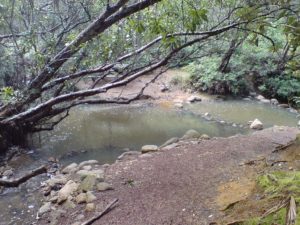 Crab Clan. These characters live in the temperate islands and along the coast of the Plains Clans. These are wooded islands, some low-lying and marshy, others mountainous. They are mid-statured (5’6″ to 6’3″), and have light tan skin; black, wavy hair; and brown eyes. Penalty to AGILITY and HEARING, bonus to STRENGTH and POWER. They fight primarily with bows and clubs, wear clothes of woven grass, and decorate with green and black paint with shell accents. Some unique resources of their region are obsidian, pickled crab, and brown spice. They live in wooden stilt-houses (over shallow water) with thatched grass roofs and go to sea in single-hull canoes with woven grass sails.
Crab Clan. These characters live in the temperate islands and along the coast of the Plains Clans. These are wooded islands, some low-lying and marshy, others mountainous. They are mid-statured (5’6″ to 6’3″), and have light tan skin; black, wavy hair; and brown eyes. Penalty to AGILITY and HEARING, bonus to STRENGTH and POWER. They fight primarily with bows and clubs, wear clothes of woven grass, and decorate with green and black paint with shell accents. Some unique resources of their region are obsidian, pickled crab, and brown spice. They live in wooden stilt-houses (over shallow water) with thatched grass roofs and go to sea in single-hull canoes with woven grass sails.
In the midst of Crab Clan territory is a low-lying island surrounded by marshes and narrow inlets, in the middle of which is a stone oval where rituals take place. The three primal Crab Clan bands live on separate islands around the mouth of the great river that empties into the sea from the Plains Clans territory.
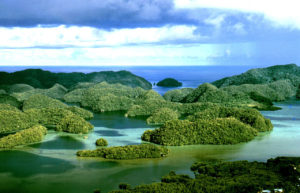 Pearl Clan. These characters live in the tropical islands and along the coasts of the Green Plains Clan and the Star Clan. Some of these islands are forested and some are arid. They are tall (5’10” to 6’4″), and have dark tan skin; black, curly hair; and brown eyes. Penalty to GRIT and ACCORD, bonus to FEROCITY and CHARM. They fight primarily with blowguns and clubs, wear clothes of woven grass, and decorate with orange and black paint with feather accents. Some unique resources of their region are pearls, rare amberwood, and exotic feathers. They live in wood round-houses with thatched grass roofs and go to sea in double-hull canoes with woven grass sails.
Pearl Clan. These characters live in the tropical islands and along the coasts of the Green Plains Clan and the Star Clan. Some of these islands are forested and some are arid. They are tall (5’10” to 6’4″), and have dark tan skin; black, curly hair; and brown eyes. Penalty to GRIT and ACCORD, bonus to FEROCITY and CHARM. They fight primarily with blowguns and clubs, wear clothes of woven grass, and decorate with orange and black paint with feather accents. Some unique resources of their region are pearls, rare amberwood, and exotic feathers. They live in wood round-houses with thatched grass roofs and go to sea in double-hull canoes with woven grass sails.
In the midst of Pearl Clan territory is a rocky islet with a stone oval on top where rituals and trading events take place, often including other clans. The three primal Pearl Clan bands live on separate islands in the tropical and sub-tropical islands to the far east. The arid tropical islands along the Star Clan coast are uninhabited.
LAKE CLANS. This central region is a lake that stretches from the arctic north to the tropical south, with several islands. The shores are variously rocky, sandy, and marshy. Three rivers flow into the lake through the mountains along the western shore, one flows from the frigid north, and one from the desert south. The lake drains through the great river that divides the plains to the east.
There are crocodiles in the south, and giant predatory sturgeon in the north, with manatees and many types of unique fishes throughout. There are gomphotheres in the marshy shore areas. The Lake Clans are generally short (5’3″ to 6′), with black or brown, curly hair; and brown or hazel eyes. They navigate the lake in canoes that have leather or woven grass sails, but can also be rowed.
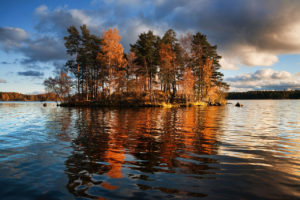 Turtle Clan. These characters live in the northern half of the lake, either on the islands or along the shores. They are light tan-skinned. Penalty to HEART and FEROCITY, bonus to HARDINESS and ACCORD. They fight primarily with bows and spears, wear clothes of leather or fur, and decorate with blue and white paint with turtle-shell accents. Some unique resources of their region are turtle shells, smoked fish, and black gomphothere tusks. They live in stone or wood long-houses with wood and bark roofs.
Turtle Clan. These characters live in the northern half of the lake, either on the islands or along the shores. They are light tan-skinned. Penalty to HEART and FEROCITY, bonus to HARDINESS and ACCORD. They fight primarily with bows and spears, wear clothes of leather or fur, and decorate with blue and white paint with turtle-shell accents. Some unique resources of their region are turtle shells, smoked fish, and black gomphothere tusks. They live in stone or wood long-houses with wood and bark roofs.
Along the northern coast is a sacred cove where boats gather for rituals and trading events, which often include other clans. The three primal bands of the Turtle Clan live on islands in the three archipelagos in the north half of the lake, but they can (of course) colonize the shores as well.
 Eel Clan. These characters live in the southern half of the lake, either on the islands or along the shores. They are dark tan-skinned. Penalty to CHARM and HARDINESS, bonus to HEART and POWER. They fight primarily with bows and spears, wear clothes of woven grass, and decorate with green and white paint with crocodile-tooth accents. Like the Smoke Clan, they start with smoking technology. Some unique resources of their region are smoked eel, smoked fish, and green spice. They live in wood stilt-houses with thatched grass roofs.
Eel Clan. These characters live in the southern half of the lake, either on the islands or along the shores. They are dark tan-skinned. Penalty to CHARM and HARDINESS, bonus to HEART and POWER. They fight primarily with bows and spears, wear clothes of woven grass, and decorate with green and white paint with crocodile-tooth accents. Like the Smoke Clan, they start with smoking technology. Some unique resources of their region are smoked eel, smoked fish, and green spice. They live in wood stilt-houses with thatched grass roofs.
Near the southern coast is a sandy, low-lying island where rituals and trading events occur, often including other clans. Two of the three primal bands of the Turtle Clan live on islands in the two archipelagos in the south half of the lake, the third living in marshes near the mouth of the great river.
PLAINS CLANS. This central region is a plan between the lake and the sea, through which flows the great river, flowing from the lake to the sea and dividing the two clans. There are a few isolated, wooded hills as landmarks. There are mammoths, dire wolves, flightless predatory birds, lions, bears, horses, gazelles, glyptodonts, and archaic humanoids representing Homo erectus in the isolated, wooded hills. The Plains Clans are mid-statured (5’6″ to 6’3″).
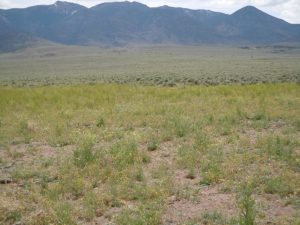 Yellow Clan. These characters live to the north of the great river. They are light-skinned, with blonde or red, wavy hair and hazel or blue eyes. Penalty to FEROCITY and POWER, bonus to HEART and SEEING. They fight primarily with bows and clubs, wear clothes of fur or leather, and decorate with yellow and black paint with lion- or horse-tail accents. Some unique resources of their region are white mammoth tusks, honey, and tin, although tin-working is not available at the beginning of the game.
Yellow Clan. These characters live to the north of the great river. They are light-skinned, with blonde or red, wavy hair and hazel or blue eyes. Penalty to FEROCITY and POWER, bonus to HEART and SEEING. They fight primarily with bows and clubs, wear clothes of fur or leather, and decorate with yellow and black paint with lion- or horse-tail accents. Some unique resources of their region are white mammoth tusks, honey, and tin, although tin-working is not available at the beginning of the game.
Atop one of the wooded hills in this region is a sacred grove of oak where rituals and trading events take place, often including other clans. The three primal Yellow Clan bands live around this sacred hill.
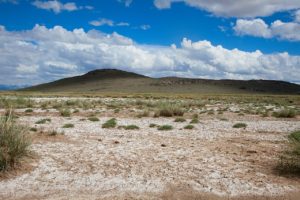 Green Clan. These characters live to the south of the great river. They are tan-skinned, with black or brown, wavy hair and hazel or brown eyes. Penalty to HEART and SEEING, bonus to FEROCITY and ACCORD. They fight primarily with bows and spears, wear clothes of leather, and decorate with green and black paint with wolf- or horse-tail accents. Some unique resources of their region are white spice, gray mammoth tusks, and apples.
Green Clan. These characters live to the south of the great river. They are tan-skinned, with black or brown, wavy hair and hazel or brown eyes. Penalty to HEART and SEEING, bonus to FEROCITY and ACCORD. They fight primarily with bows and spears, wear clothes of leather, and decorate with green and black paint with wolf- or horse-tail accents. Some unique resources of their region are white spice, gray mammoth tusks, and apples.
Atop one of the wooded hills in this region is a sacred grove of birch where rituals and trading events take place, often including other clans. The three primal Green Clan bands live around this sacred hill.
REPUTATION AND ECONOMY
 Since there is no monetary system in a Stone Age setting, the economy of Lithic would rely on reciprocity, which ties into character REPUTATION. In many MMORPGs, there is a REPUTATION system based on a simple dynamic of evil vs. good. If the character does bad things, his or her “wanted level” goes up. If the character does good things, a sort of “honor” rises.
Since there is no monetary system in a Stone Age setting, the economy of Lithic would rely on reciprocity, which ties into character REPUTATION. In many MMORPGs, there is a REPUTATION system based on a simple dynamic of evil vs. good. If the character does bad things, his or her “wanted level” goes up. If the character does good things, a sort of “honor” rises.
But, in Lithic, this is complicated by the factional clan system, but in an immersive way. There would be two levels of interaction.
At the macro-scale, between each clan and all other clans would be a RELATIONS measure to define what members of the clans (particularly NPCs) think of members of the other clan. This is largely driven by individual acts of hostility, neutrality, and aid between characters.
The RELATIONS scale between clans falls into five broad categories, with nuance in the numbers underneath that would be hidden from the players: ALLIANCE, AMITY, NEUTRALITY, RIVALRY, HOSTILITY.
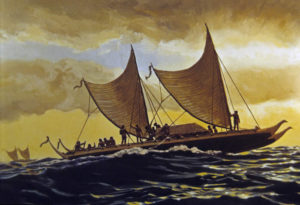 At the micro-scale, each PC would have two REPUTATIONs, one with the PC’s own clan and one with each foreign clan. Internal REPUTATION falls along a scale of HEROIC, LOYAL, NEUTRAL, SUSPICIOUS, and TREASONOUS. External REPUTATIONs with other clans fall along a scale of HONORABLE, ETHICAL, NEUTRAL, SHAMEFUL, INFAMOUS. These are roughly analogous to the RELATIONs categories.
At the micro-scale, each PC would have two REPUTATIONs, one with the PC’s own clan and one with each foreign clan. Internal REPUTATION falls along a scale of HEROIC, LOYAL, NEUTRAL, SUSPICIOUS, and TREASONOUS. External REPUTATIONs with other clans fall along a scale of HONORABLE, ETHICAL, NEUTRAL, SHAMEFUL, INFAMOUS. These are roughly analogous to the RELATIONs categories.
In general, internal REPUTATION increases when the PC acts friendly toward other clan members, and acts toward foreign clan members in accordance with the clan’s RELATION with the other clan. External REPUTATION is driven simply by whether the PC is nice or mean to members of that clan.
Internal REPUTATION affects how clan NPCs cooperate with the PC, like trading, building a house, or joining a hunt. External REPUTATION affects the PC’s ability to trade with foreigners and how much hostility they can expect to face from foreign NPCs and dialed-in foreign PCs.
So, in a very real sense, REPUTATION constitutes the social currency of Lithic. It would massively affect gameplay outcomes. The PC’s REPUTATION is affected by multiple actions.
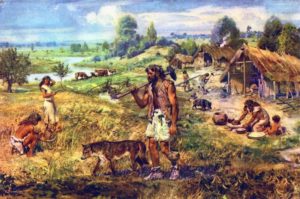 Combat actions would include attacking other characters, but also acknowledging other characters without hostility. Obviously, attacking fellow clan members would adversely affect internal REPUTATION. But, the more interesting dynamic is external REPUTATION.
Combat actions would include attacking other characters, but also acknowledging other characters without hostility. Obviously, attacking fellow clan members would adversely affect internal REPUTATION. But, the more interesting dynamic is external REPUTATION.
If the PC sees a member from another clan who also sees the PC, and no hostilities ensues, this raises the PC’s REPUTATION with that clan, which in turn affects (in a smaller way) the PC’s clan’s RELATION with that clan. However, not attacking the member of a clan with which one’s own clan has RIVALRY or HOSTILITY can negatively affect the PC’s REPUTATION in his/her own clan. It’s a very nuanced path to walk.
Trading actions also affect REPUTATION. Since trade always involves a consensual agreement to exchange pre-determined goods, a successful trade results in a positive affect on the PC’s REPUTATION. A failed trade, when the PC rejects the other’s offering or the other rejects the PC’s, can have a negative affect on the PC’s REPUTATION if the disparity is strong enough. There should be a degree of wiggle room to take into account honestly different interests.
The third way actions can affect a PC’s REPUTATION is a form of delayed trade. For example, some character gives the PC a gift or performs some service for the PC, be it helping the PC do something, healing the PC, or feeding the PC. When this happens, the PC incurs a DEBT tied to the individual provider character and the provider’s clan.
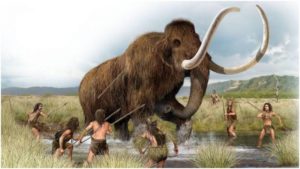 The receiving character must repay this DEBT in some way soon in the future, or suffer penalties to his or her REPUTATION with the provider character and his/her clan. The sooner this DEBT is repaid, the better, and the DEBT is erased from the PC’s record as its repayment registers in the PC’s REPUTATION. At a certain time limit (to be determined by the developers) the DEBT is defaulted and is deleted as the PC’s REPUTATION with that provider character and his/her clan goes down.
The receiving character must repay this DEBT in some way soon in the future, or suffer penalties to his or her REPUTATION with the provider character and his/her clan. The sooner this DEBT is repaid, the better, and the DEBT is erased from the PC’s record as its repayment registers in the PC’s REPUTATION. At a certain time limit (to be determined by the developers) the DEBT is defaulted and is deleted as the PC’s REPUTATION with that provider character and his/her clan goes down.
Every REPUTATION-affecting action of a PC with a character outside that PC’s clan influences the RELATIONS between those clans. Likewise, the existing RELATIONS between clans can alter the REPUTATION-affecting actions of the PC.
In general a PC’s individual REPUTATION in a foreign clan will slowly drift toward the parallel RELATION status between the clans as time passes after the act that changed the individual PC’s REPUTATION with that foreign clan. So, a player has to keep being nice to outsiders to maintain that positive external REPUTATION.
Which bring us back to inter-clan RELATIONs. ALLIANCE indicates that the clan considers the foreign clan’s interests to be completely intertwined with their own; clan NPCs will immediately come to the aid of foreign characters held in ALLIANCE. AMITY is a sort of light version of ALLIANCE, instilling a less immediate response. NEUTRALITY is essentially a passive RELATION, but can be a powerful influence as PC actions could strongly affect whether the two clans move toward ALLIANCE or HOSTILITY.
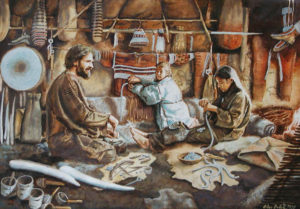 RIVALRY is a light version of HOSTILITY, which indicates that the clan considers the foreign clan to be a mortal enemy. Encountering a clan that considers your clan in HOSTILITY will certainly result in conflict with NPCs, if not PCs.
RIVALRY is a light version of HOSTILITY, which indicates that the clan considers the foreign clan to be a mortal enemy. Encountering a clan that considers your clan in HOSTILITY will certainly result in conflict with NPCs, if not PCs.
The existence of bands within clans complicates matters, since bands can go ROGUE and confound a clan’s interests both internally and externally.
To simplify this, bands should have internal clan REPUTATION tied to the individual internal REPUTATIONS of its members. Any band with a significant number of PC members with TREASONOUS REPUTATION would be declared ROGUE, a status that essentially separates the band’s inter-clan RELATIONs from the clan’s. A band can regain acceptance in the clan by members taking actions more in alignment with the clan’s interests, or can actually join another clan by aligning with that clan’s interests.
Likewise, unless declared ROGUE, a band’s RELATIONs with foreign clans are perfectly aligned to their clan’s RELATIONs, and all of the band members’ actions affect the entire clan’s RELATIONs. Once declared ROGUE, the band has its own RELATIONs with other clans, and with other bands declared ROGUE.
ENVIRONMENTAL EFFECTS
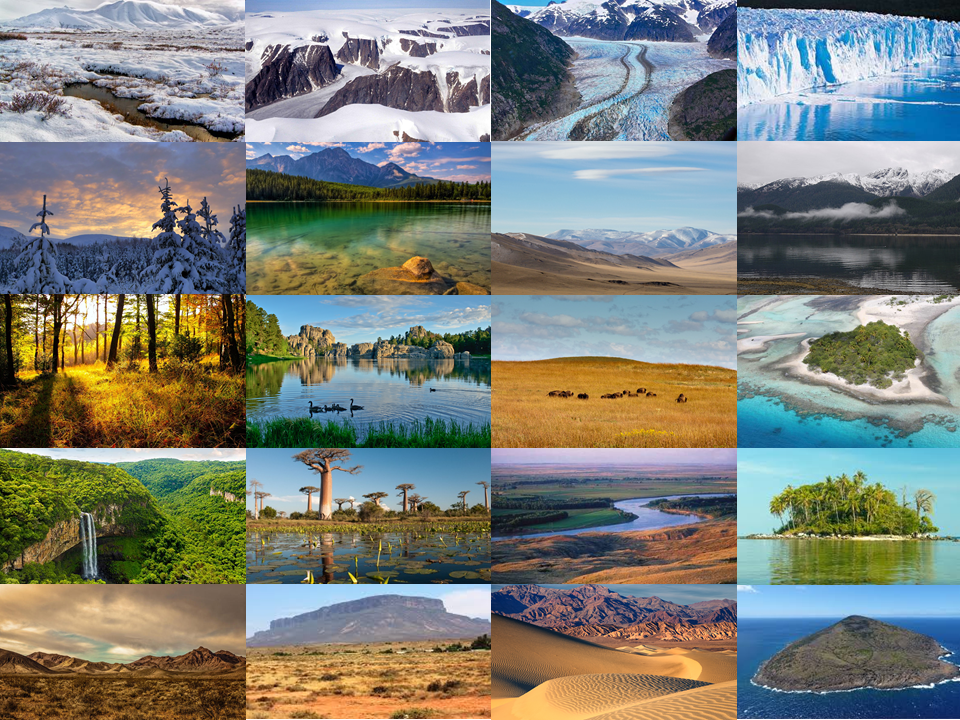 The environment has affects on BODY and, secondarily, the PERSON of characters. The basic dynamic is that a PC is well-suited to act in his or her native environment and suffers penalties in foreign areas.
The environment has affects on BODY and, secondarily, the PERSON of characters. The basic dynamic is that a PC is well-suited to act in his or her native environment and suffers penalties in foreign areas.
The specific environmental effects would be temperature, humidity, wind, and solidity, the last of which represents the steadiness of one’s footing, which includes swampy stickiness, shifting sand, and the unsteady footing of boats on the water which can lead to sea-sickness.
Effects to which the character is unaccustomed would register in penalties to the PERSON, SPIRITUALITY, PERCEPTION, or even BODY attributes. Temperature particularly affects BODY and can even lead to death. Humidity, an excess or absence of water, can effect BODY (primarily in absence) but also PERSON, PERCEPTION, and SPIRITUALITY. Wind primarily affects PERSON and PERCEPTION. Solidity affects PERSON and SPIRITUALITY most strongly, as well as pace of movement, characters generally benefiting from higher solidity.
The basic dynamic is that a character is most effective on native grounds, and suffers penalties when they travel beyond their clan grounds.
Temperature. The lands of the Snow Clans are sub-normal in temperature while the lands of the Sand Clans are super-normal in temperature. Among the Forest Clans, the Mist Clan’s lands are sub-normal while the Rain Clan’s lands are super-normal. Among the Sea Clans, the Seal Clan’s lands are sub-normal while the Pearl Clan’s lands are super-normal. All other lands are considered normal.
Humidity. The lands of the Sand Clans are sub-normal in humidity, while the lands of the Forest Clans are super-normal. Among the Pearl Clan, some islands are sub-normal and some are super-normal, thus affecting characters based not on clan but on headquarters. All other clan regions are normal.
Wind. The lands of the Snow Clans, the Plain Clans, and the Moon Clan are super-normal in winds. The lands of the Forest Clans are sub-normal. All other regions are normal.
Solidity. The lands of the Sun and Star Clans are super-normal in the solidity of the earth. The lands of the Lake Clans, the Snow Clans, and the Crab Clan are sub-normal. All other regions are normal.
TIME AND THE SEASONS
I would want the four seasons in the game world to cycle weekly, creating a four-week game year. This sort of seasonal thing has been done in other MMORPGs, but in a Stone Age setting it would be essential. Each season would have different opportunities for hunting and gathering, as well as different environmental factors. It would also affect agriculture and animal husbandry, once cultivation and domestication was discovered.
In the Lithic setting, winter would decrease temperature in all regions. This would bring snow into the temperate regions. Spring would increase humidity, bringing rare rains to the Sand Clans, torrential rains to the Forest Clans, and blizzards to the Snow Clans. Spring would also bring new growth, flowers, and young animals to most regions.
Summer would increase temperature in all regions, creating a brief growing season to the Snow Clans. Autumn would bring a harvest of plants. In addition, animals would migrate with the seasons, changing the hunting opportunities.
The day-night cycle in Lithic would match up to two hours of real time. This gives each season 84 days, which is only a few days shorter than in the real world. Thus, a Lithic year would be 336 game days.
ASTRONOMY/ASTROLOGY
 The starscape of the game would be unique, with four novel constellations marking the coming of the seasons; the names of these constellations and their stars would be left up to the players, but the brightest stars of each constellation (the four brightest stars in the sky) would each have a distinctive color: yellow for Spring, white for Summer, red for Autumn, and blue for Winter. The sun cycle would be aligned to the stars, moving through the a full annual cycle every four weeks, but the Moon would move somewhat off-synch to create an interesting dynamic.
The starscape of the game would be unique, with four novel constellations marking the coming of the seasons; the names of these constellations and their stars would be left up to the players, but the brightest stars of each constellation (the four brightest stars in the sky) would each have a distinctive color: yellow for Spring, white for Summer, red for Autumn, and blue for Winter. The sun cycle would be aligned to the stars, moving through the a full annual cycle every four weeks, but the Moon would move somewhat off-synch to create an interesting dynamic.
You know what, to hell with it, let’s throw in a second moon! The first would be a large, gray-white moon like the real-world one, which drives tides, occasionally eclipses the sun or is eclipsed, and moves through a full cycle every 56 real-world hours (a little over two real-world days) which would be 28 game-world days, roughly like the real-world Moon. A smaller, brighter moon, maybe yellowish or orange, would move through a full cycle every 14 real-world hours, seven game-world days thus one week.
Specific magical effects would be buffed or nerfed based on the solar solstices and equinoxes, on the rising of the brightest star of a seasonal constellation at sunset, at solar or lunar eclipses, when the smaller moon crosses the larger one, and when either moon is conjunct with a seasonal star. These moments would enable specific sun-, moon-, or star-based astrological skills, enhanced by the megalithic structures of the Sand Clans.
These dynamics would affect not only POWER in creating items and casting spells, but also other spiritual attributes SEEING, ACCORD, and FORESIGHT. This dynamic would be an immense boost to immersion.
AGING, DEATH, AND RESPAWNING
As time passes in Lithic, one year every four weeks, so would the characters age. PCs would start in Stone Age “adulthood”—in their mid teens after a traditional initiation around age 13. Thus they would have several years of what 21st century people might call “adulting” practice under their Stone Age belts, or whatever holds up their clothes. This justifies basic, beginner skills, but also starts characters a bit weaker than the full adults they’ll soon grow into.
Thus advancement begins by growing into adulthood, during which time the PC would gain in certain initially nerfed attributes, particularly STRENGTH. After about six weeks (three in-game years), the PC would be a full-fledged adult, gaining certain privileges in the clan, like the ability to establish one’s own band by setting up a new headquarters.
MMORPGs have been known to last decades, like Ultima Online. Others, not so long. If Lithic lasted ten years, that would be 130 years in game time, long enough for multiple generations of characters. That would be pretty impressive.
This aging dynamic also means that every PC will eventually become an elder, starting at 60 in-game years (about two and a third real-world years), and can from that point die permanently “from old age.” This death-by-old-age would be permanent, but of course characters can also die by other means, say in battle, from exposure, from starving, or from disease. In these cases, the PC would go through the established MMORPG tradition of respawning.
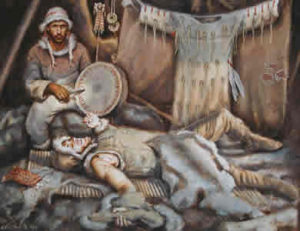 The respawning dynamic in Lithic would be nuanced with the intention of fostering immersive realism and social, factional interaction.
The respawning dynamic in Lithic would be nuanced with the intention of fostering immersive realism and social, factional interaction.
When a player dies by causes other than old age or in Critical Moments (described below), the game respawns them at the nearest NPC with healing skill, regardless of the clan of that healer. This is fairly simple when the healer is the same clan as the player or an allied clan. But, when the clan is not allied, a special dynamic ensues in which the healer’s clan receives some bonus (to be determined during design) that only manifests if the respawned character is not killed by a member of the reviving clan for a set amount of time. Perhaps the designers would even implement a distance factor to prevent hostile reviving clans from tracking the respawned character beyond the deadline.
This creates a certain degree of immersive realism without overly penalizing characters who find themselves dead in foreign territory.
Another novel dynamic regarding character death would be the aforementioned Critical Moments, in-game events limited by area. These could be hunting opportunities, battles with NPC creatures, battles between factions, or weather events. In general, these would be planned away from clan headquarters so that players could choose whether or not to participate. This opt-in dynamic is because, during a Critical Moment, character death would be permanent.
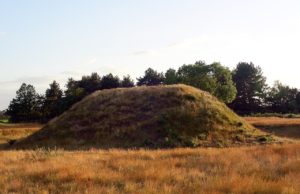 This would allow players the opportunity to risk retiring characters in a heroic manner, in order to create new ones. To foster this dynamic, each player would be allowed only one character. When a character dies during a Critical Moment, the character’s body does not respawn. The player must create a new character. However, the body can be retrieved and honored in the clan territory by the building of a cairn, kurgan, tomb, etc. the construction of which is unlocked by the death of a PC clan member.
This would allow players the opportunity to risk retiring characters in a heroic manner, in order to create new ones. To foster this dynamic, each player would be allowed only one character. When a character dies during a Critical Moment, the character’s body does not respawn. The player must create a new character. However, the body can be retrieved and honored in the clan territory by the building of a cairn, kurgan, tomb, etc. the construction of which is unlocked by the death of a PC clan member.
The existence of such burial sites also creates an opportunity for undead monsters. This would include skeletons, full-bodied wights, and purely spiritual wraiths haunting both burial sites and places where planned, Critical Moments had occurred. In addition, NPCs killed by players in a particularly brutal way could become revenant wights, following and harassing the PCs who killed them.
OFFLINE PRESENCE
Another innovation to Lithic would be to give PCs an ongoing presence even with players are offline, going about work-a-day tasks like tending gardens (once cultivation is discovered!), managing herds (once domestication is discovered!), building structures, or learning skills from NPCs. These offline PCs could be encountered by other players during this time, but cannot join missions or exploring. Players would be encouraged to record a set of standard verbal responses that would indicate to online players that the PC was in offline mode.
This would play into the pre-literate setting, as characters cannot learn anything from books. Instead, players could assign their characters to apprentice to a skilled NPC to learn a new skill, or to an elder to learn new oral traditions, before logging off.
This offline presence would also maintain the immersive verisimilitude by having PCs continue maintaining their homes, visible to other players, even while the player is off in the real world.
If the PC is away from home at the time of log-off, the character could either be set to “maintain camp,” in which case they would stay at the camp site and keep the fire burning, or “return home,” in which case the PC would wayfind toward the character’s home, with enhanced hardiness and movement speed to avoid being ganked too often on the way back.
In essence, an offline PC becomes an NPC with tasks specified by the player before logging off.
SKILLS
The skills available to characters would include combat, hunting, gathering, tracking, crafting, astrology, spell-casting, etc. Certain skills would lead to the discovery of novel skills not available at the beginning of the game. For example, hunting would lead to the domestication of animals, gathering would lead to the cultivation of plants, crafting mud-brick buildings would lead to pottery.
At the beginning of the game, no plants or animals would be domesticated, pottery would not be invented, and no metallurgy would be present. There would be both plants and animals to be exploited as resources that could be gathered or hunted. But only a few species would be open to domestication or cultivation, and these would be hidden from beginning players, to add to immersion. Players would have to discover what could be domesticated or cultivated and what could not.
Which plants could be planted and cultivated? Beginning players would not know. Which animals would tolerate human guidance and let themselves be tamed or even, at later stages, yoked or ridden? Again, that would be something for game designers to work out and players to discover in the course of gameplay.
There are many possibilities. Grains, fruits, legumes, tubers, spices to be cultivated. Horses, donkeys, sheep, donkeys, cows, elephants, wolves, cats, birds to be domesticated. Which animals can be merely domesticated for food, which can be yoked for labor, and which can be ridden (skills to be discovered in gameplay)? These are details for the game-runners to reveal to players in the course of gameplay.
SPELLS AND SPIRITUALITY
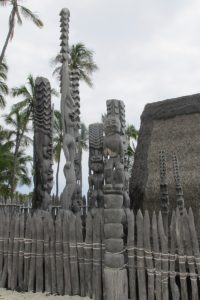 Spells include both magic of immediate effect, governed by the spell-casting skill, and magics of lasting effect, governed by the totem crafting skill. Totemic magic either inheres in idols, totemic items attached to areas, or images attached to mobile items. This could include petroglyphs, carvings into trees, or even tattoos on characters.
Spells include both magic of immediate effect, governed by the spell-casting skill, and magics of lasting effect, governed by the totem crafting skill. Totemic magic either inheres in idols, totemic items attached to areas, or images attached to mobile items. This could include petroglyphs, carvings into trees, or even tattoos on characters.
The different types of magic include:
Healing magic that increases BODY attributes that have been reduced. This is often specific as to the type of harm they heal.
Harming magic decreases BODY attributes, either with immediate harm or progressive harm. Harming magic has a variety of expressions: wounds, fire, cold, disease.
Protection magic defends various attributes from negative effects. This is often specific to types of harm to BODY, discomfort to PERSON, effects on PERCEPTION, or influences on SPIRITUALITY.
Charming magic can influence the behavior of NPCs and the PERCEPTION and SPIRITUALITY of PCs.
Illusion magic creates false PERCEPTION, variously effecting VISION, HEARING, SCENT, or SEEING. It can also create sensations of temperature that effect PERSON without harming BODY.
Divination magic either allows PERCEPTION at a distance, or enables access to prophecy cinematics created by game-runners to preview upcoming in-game events. Divination relies heavily on FORESIGHT.
Magical skills have to be learned by apprenticing to skilled NPCs, which would normally take place while the PC is offline.
MONSTERS AND HUMANOIDS
Of course, there would be a wide variety of ancient beasts typical of the real-world Stone Age: cave bears, cave lions, dire wolves, glyptodonts, glomphotheres, mammoths, mastodons, woolly rhinos, giant eagles, and so on. There could also be archaisms like flightless predatory birds, giant Paraceratheres, giant sharks, archaic whales, and (in remote areas) perhaps even some feathered theropods. The developers could sprinkle in all sorts of extinct critters.
The undead and spirit races would add the magical, fantasy elements. Minor spirits would be sprite-like and mainly serve to create minor inconveniences or to foster local magical plants. Major spirits would be much more rare, and serve to protect special sites, present special challenges, or offer significant buffs or opportunities for increased magic. These major spirits would be the closest thing to gods in the setting. They would play into rituals and could have specific relationships with PCs that players could develop. The appearance of spirits would be affected by VISION, so they could appear differently to different players
Finally, the archaic humanoids would round out the experience. Of course, the Snow Clans would bring Neanderthals into the mix. Gigantopithecus would provide a giant for the fantasy setting. Homo erectus, Homo heidelbergensis, and the Australopithecines would provide the setting’s version of demihumans and goblins. The diminutive, wood-dwelling Homo floresiensis would add an elfish element.
Finally, there could be completely fantastical creatures drawn from myth. Giant serpents, monstrous squids and octopuses, mystical water panthers from North American mythology, various werecreatures, and human-animal hybrids like minotaurs, sphinxes, and centaurs.
ADVANCEMENTS, DEVELOPMENTS, AND IN-GAME EVENTS
A major draw for a game like Lithic would be the gameplay potential not present at the beginning of the game, either through advancing technology, ecological developments, gameplay developments, and in-game events.
Technological advancements would be confined to specific servers of the game world (with individual PCs embedded on specific servers) to maintain the integrity of individual manifestations of the game world. Thus, if pottery is developed in one instance of Lithic, it would remain undiscovered in the others. What are the technologies that players could discover?
Peoples who know claywork through building would more easily discover pottery, and all the preservation benefits that implies. Those who know weaving for their clothes would discover woven baskets, or eventually looming. Woodwork in housing or boatbuilding might lead to sleds, plows, and wheels.
Smoking for food preservation is a skill restricted to certain clans at the beginning of gameplay, but it could spread. The same for the bow-and-arrow and sling. Salting for preservation could be discovered, as could the atlatl.
Mining for stone and gems could lead to discoveries of copper, tin, gold, or silver. Stonework would advance from crude carving to more geometric shapes, sculpture, fitted stones. Furthermore, stone weapons would advance in their potency.
Domestication would be divided into livestock (animals kept for food) and petship (animals kept for partnership). Livestock could be further developed (depending on the species) for milk, yoking, riding. Pets would start as guardians living off scraps and warning of threats, to social partners providing comfort to PERSON, to hunting partnerships.
Cultivation of plants would advance from mere gardens to organized agriculture, sometimes dependent on irrigation, flouring to create breads, and brewing to create intoxicating drinks.
Which leads us to ecological developments, some of which are imposed top-down by game-runners and some of which would be the natural consequences of player activity that would be partly managed by game-runners.
There would be Explosions of carnivores and herbivores in cycles, dependent on players’ targeting of their populations. After the discovery of agriculture, creating farmland would cause Deforestation, which would affect animal populations. Fishing, mining, and hunting could lead to Resource Depletion, which could cause Implosions of carnivores an herbivores.
Entirely independent of player actions would be Cold Spells, Hot Spells, Droughts, and Wet Spells.
Gameplay developments would change the basis of gameplay in an evolutionary way.
To evolve the game spirituality, individual spirits become more prominent, setting themselves apart from the NPC class from which they arise. They take on more specific roles in the clan’s life, like a Trickster, a Tutelary deity protecting specific settlements, a Culture Bringer teaching new skills, a Hearth spirit protecting individual homes, a Hunting spirit helping trackers, a War spirit aiding in combat….
These specialized spirits would be named by players during gameplay. But, in essence they would arise from animistic spirituality to become gods to be appeased. They would claim sacred sites as their own and demand loyalty from characters in exchange for buffs.
Technological developments, discovered by PCs in their gameplay, would evolve the game organically. As players discovered metallurgy, domestication, cultivation and their descendants, the dynamics of the world and inter-clan interaction would change.
Finally there would be in-game events, Critical Moments, which would have great import for both individual PCs and their factions.
Clan Battles would pit faction against faction in contests that could determine control of territory.
Hominid Uprisings, Monster Infestations, and Undead Arisings could challenge the players’ control over territory contested by non-player forces.
Spiritual Revivals could pit loyalties to specific spirit creatures against others. Spirit-specific religions would be an added factional dynamic, often pitting clan loyalist against clan loyalist.
IN CONCLUSION
The Stone Age is a largely ignored era in video games, and RPGs in general. I believe it is a lively setting with many possibilities for fantasy adventure.
All of the basic play-types are there. Tanks, trackers, rogues, healers, magic-users. There are monsters, undead creatures, spirits. There are opportunities for creating bases, establishing trade, waging war. There’s crafting, exploration, diplomacy, and individual advancement.
All of this in a uniquely immersive environment designed to combine gritty realism and magical fascination. I think such a game would be immensely popular. I hope you agree.
